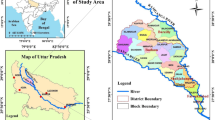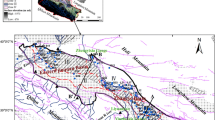Abstract
In the modern times, the population growth, development of industrial and agricultural production and the petroleum exploitation, brought about the unceasing expansion of artificial oasis and abrupt increase of water demand. The artificial hydraulic irrigation engineering took the place of the natural river system, the reservoirs took the place of natural lakes, which in turn enhanced the space-time redistribution of surface water based on the natural evolution, and so did groundwater. The groundwater recharge reduced 26.2% in 46 years from 1950 to 1995 in the southern piedmont flood plain of Tarim Basin due to mean yearly population increase rate of 27.7‰ and associated with the water use rate increasing from 24.6% to 58.4%. At the same time the artificial water system seepage give primary play to groundwater recharge, which is up to 57.6% whilst that of the natural system reduce to 33.7%. As a result, groundwater level drop 3–5m widespread except some irrigation area and surroundings of plain reservoir. Spring water discharge also reduce about 37.6% and discharge zone continuously move away to the north with the value of 0.5–1.2km in the past 40 years.
Similar content being viewed by others
References
FAN Xi-peng, 1990. The groundwater and environmental problem of water resources development in the arid land of NW China [J]. Hydrogeology and Engineering Geology, 15(2): 12–16. (in Chinese)
MA Jin-zhu, 2001. Assessing the groundwater vulnerability in the south edge of Tarim Basin[J]. Journal of Desert Research, 21(2): 170–174. (in Chinese)
MA Jin-zhu, LI Ji-jun, 2001. The groundwater resources and its sustainable development in the south edge of Tarim Basin[J]. Chinese Geographical Science, 11(1):57–62.
MA Jin-zhu, QIAN Ju & GAO Qian-zhao, 2000. The groundwater evolution and its influence on the fragile ecology in the south edge of Tarim Basin[J]. Journal of Desert Research, 20(2): 145–149. (in Chinese)
SHI Ya-feng, ZHANG Xiang-song, 1995. Impact of climate change on surface water resources in the arid land of NW China[J]. Science in China(Series B), 25(9): 968–977. (in Chinese)
TANG Qi-chen, QU Yao-guang, ZHOU Yu-chao, 1992. The hydrology and water resources used in arid areas of China[M]. Beijing: Science Press, 147–191. (in Chinese)
Author information
Authors and Affiliations
Additional information
Foundation Item: Under the auspices of the National Natural Science Foundation of China (No. 49731010).
Biography: MA Jin-zhu (1968–), male, a native of Jingning County of Gansu Province, Ph. D., associate professor. His research interests include water resources and environment in arid zones.
Rights and permissions
About this article
Cite this article
Ma, Jz., Lai, Tw. & Li, Jj. The impact of human activities on groundwater resources in the south edge of Tarim Basin, Xinjiang. Chin. Geograph.Sc. 12, 50–54 (2002). https://doi.org/10.1007/s11769-002-0070-4
Received:
Issue Date:
DOI: https://doi.org/10.1007/s11769-002-0070-4




